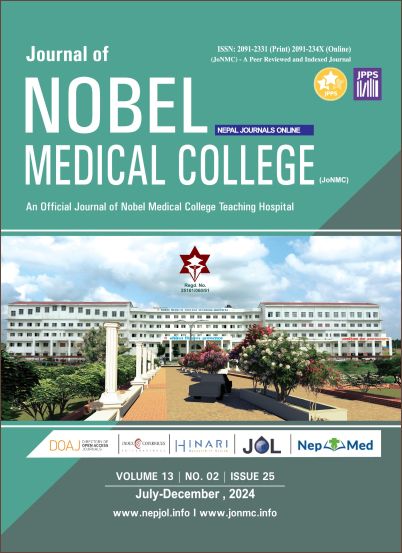Histopathological Pattern of Endometrial Biopsies in Patients with Abnormal Uterine Bleeding in a Tertiary Referral Hospital
DOI:
https://doi.org/10.3126/jonmc.v13i2.74448Keywords:
Dilatation and Curettage, Endometrium, Uterine BleedingAbstract
Background: Abnormal Uterine Bleeding is the condition wherein symptom deviates from the normal menstrual cycle. The histopathogical examination of the tissue obtained from endometrial biopsy is considered as gold standard for diagnosis. The aim of this study is to identify the histopathological pattern of endometrial biopsies in patients with abnormal uterine bleeding, across different age and parity groups, who have undergone dilation and curettage.
Materials and Methods: A cross sectional study was done in Nobel Medical College Teaching Hospital, Pathology department for period of 1 year (October 2023 to October 2024). Total 385 patients presenting with complains of abnormal uterine bleeding at Gynecology department were included. Endometrial biopsy samples were collected by dilation and curettage,routinely processed, stained with Hematoxylin & Eosin and examined under light microscopy. The data was recorded in standard proforma and entered into the Statistical Package for Social Science software Ver.20 and were analyzed for descriptive and inferential statistics.
Results: Out of 385 specimens examined 35 were inadequate for evaluation. Majority of patients were in reproductive age groups 139 (40%) followed by premenopausal 125 (35%) and post-menopausal 86 (25%). Out of 125 (32.5%) cases diagnosed as functional endometrium, 84 (21.8%) showed secretory changes and 41 (10.6%) showed proliferative changes. This was followed by the weakly proliferative endometrium 25 (6%) cases. Among the organic causes of abnormal uterine bleeding, benign endometrial lesions were commonest comprising 42 (10.9%) cases while 23 (5.9%) were malignant lesions. Pregnancy related changes were seen in 35 (9.2%) cases.
Conclusion: In this study the majority of cases are clustered around the reproductive age group along with the secretory and proliferative endometrium being the major cause for abnormal uterine bleeding.
Downloads
Downloads
Published
How to Cite
Issue
Section
License
Copyright (c) 2024 The Author(s)

This work is licensed under a Creative Commons Attribution 4.0 International License.
JoNMC applies the Creative Commons Attribution (CC BY) license to works we publish. Under this license, authors retain ownership of the copyright for their content, but they allow anyone to download, reuse, reprint, modify, distribute and/or copy the content as long as the original authors and source are cited.




